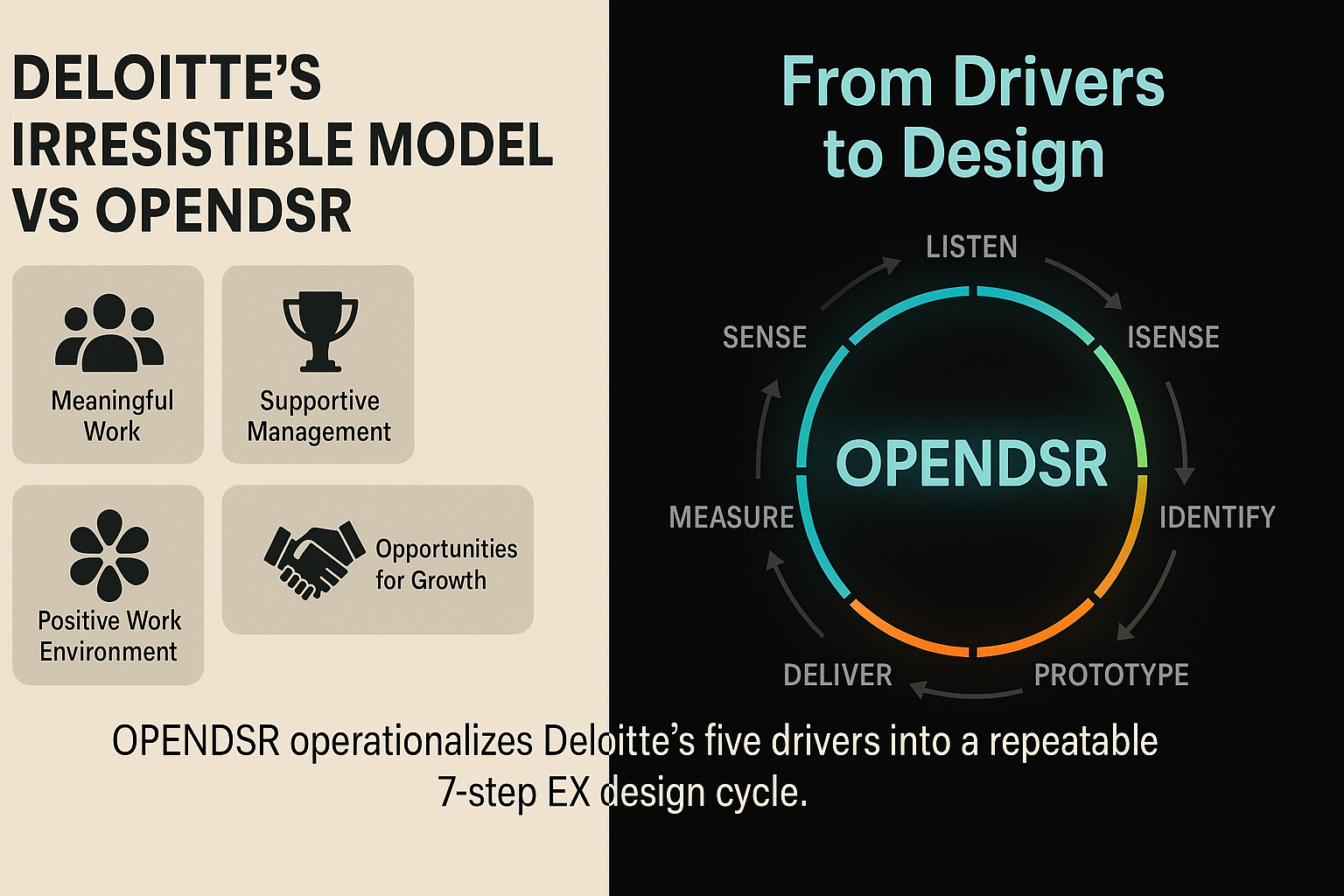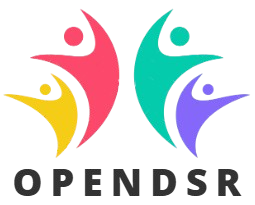
Deloitte’s Irresistible Model vs OPENDSR: From Drivers to Design
Deloitte’s Irresistible Model vs OPENDSR: From Drivers to Design Operationalizing Deloitte’s Five EX Drivers through the 7-Step OPENDSR Cycle 1. Introduction: From Inspiration to Implementation
For over a decade, Deloitte’s Irresistible Organization Model (also known as the Simply Irresistible Model, or Deloitte EX Model) has guided HR and business leaders toward building workplaces where employees genuinely want to stay, grow, and contribute. It reframed employee experience (EX) from perks and engagement scores to human drivers—meaning, growth, trust, purpose, and belonging.
However, as organizations transitioned into hybrid, AI-augmented, and experience-driven work ecosystems, a new challenge emerged:
How do we operationalize these human drivers in real-time — ensuring that insights translate into action across the enterprise?
This is precisely where the OPENDSR Framework bridges the gap.
While Deloitte’s Irresistible Model defines why people engage, OPENDSR defines how organizations can design, measure, and continuously refine that engagement.
This article explores that bridge — showing how OPENDSR transforms Deloitte’s five EX drivers into a practical, iterative, and scalable design cycle that embeds empathy and intelligence into every layer of employee experience.
2. Understanding Deloitte’s Irresistible Organization Model 2.1 The Genesis
Introduced by Josh Bersin and Deloitte’s Human Capital research team, the Irresistible Organization Model emerged from a decade of studying what makes organizations magnetic to talent — not just attractive but irresistible. The model distills thousands of employee surveys into five core drivers that consistently correlate with high engagement, performance, and retention.
2.2 The Five Core Drivers Driver Definition Key Components Intended Outcome Meaningful Work Work that aligns with purpose and autonomy Empowerment, trust, mastery Deep engagement, innovation Supportive Management Managers who coach, not command Feedback, clarity, development focus Growth and psychological safety Positive Work Environment Culture of inclusion, flexibility, and recognition Well-being, belonging, team spirit Joy and retention Growth Opportunity Continuous learning and mobility Reskilling, mentorship, internal movement Career longevity Trust in Leadership Transparency, fairness, and shared purpose Vision, ethics, authenticity Commitment and resilience 2.3 Strengths and Limitations
The Deloitte model offers a deeply human lens — elevating purpose and trust as equal to pay and performance. However, in practice, organizations often struggle to move from measurement to movement. Many EX initiatives remain survey-bound — rich in insights but weak in iterative execution.
Strengths Limitations Scientifically validated across industries Static model — limited adaptability Holistic (psychological + organizational) Lacks operational framework for real-time design Universally relevant Requires translation into digital action layers Anchored in purpose and belonging Not systematized for ongoing feedback or iteration
This is where OPENDSR steps in — not to replace Deloitte’s model, but to bring it alive in motion.
3. OPENDSR: The Design Engine for Human-Centered EX 3.1 Overview
OPENDSR stands for Observe, Prioritize, Envision, Navigate, Design, Systematize, Refine — a 7-step Human-Centered Experience (HCX) operating cycle developed to convert insights, empathy, and experience data into structured action.
It is not a replacement for existing EX models (like Deloitte’s or IBM’s) but a metaframework — an operating layer that unites design thinking, behavioral science, and data intelligence.
Step Description Purpose in EX Design Observe Collect qualitative and quantitative insights Understand lived realities of employees Prioritize Identify experience gaps that matter most Align focus with strategic value Envision Reimagine new experiences and prototypes Translate insights into possibility Navigate Co-design journeys with stakeholders Ensure inclusivity and cross-functional input Design Develop tangible interventions and workflows Move from idea to implementation Systematize Embed in systems, policies, and tools Scale through technology and governance Refine Continuously learn, adapt, and improve Sustain agility and relevance 3.2 Core Philosophy
Where Deloitte’s model describes drivers, OPENDSR defines the drive — the repeatable mechanism that turns human insight into organizational behavior.
OPENDSR = “How to operationalize humanity through design.”
It blends empathy (soft signals) with evidence (data intelligence), ensuring that employee experience is both emotionally resonant and systemically sustainable.
4. From Drivers to Design: Mapping Deloitte’s Model to OPENDSR
The most powerful synergy between Deloitte’s Irresistible Model and OPENDSR lies in their complementarity. One offers direction (why employees engage), and the other provides method (how organizations act).
Below is a detailed crosswalk showing how each of Deloitte’s five drivers can be designed and operationalized through the seven steps of OPENDSR:
4.1 The Integration Matrix Deloitte EX Driver OPENDSR Step Action Example Outcome Meaningful Work Observe → Envision Capture stories of purpose and redesign workflows for autonomy Employees see alignment between personal values and company goals Supportive Management Navigate → Design Co-create manager enablement toolkits using real-time feedback Managers shift from evaluators to coaches Positive Work Environment Design → Systematize Build flexible policy layers within digital HR platforms Embedded culture of inclusion and recognition Growth Opportunity Prioritize → Design Use skill-mapping dashboards and internal mobility AI Employees see transparent, data-backed growth paths Trust in Leadership Observe → Refine Real-time listening dashboards for transparency Leadership actions visibly mirror organizational intent 5. Comparative Lens: Deloitte vs OPENDSR Aspect Deloitte’s Irresistible Model OPENDSR Framework Integration Potential Core Purpose Define key human drivers of engagement Operationalize EX through systemic design Converts intent into movement Approach Type Conceptual, diagnostic Iterative, applied Theory meets execution Focus Culture and leadership behavior Process, design, and feedback loops Complements leadership mindset with design tools Temporal Scope Static snapshots (surveys, models) Continuous refinement (data + feedback) Makes EX dynamic and real-time Output Insights and recommendations Prototypes, policies, and embedded tools Moves from data to design Data Use Periodic surveys, sentiment analysis Real-time pulse and journey data Empathy meets evidence Scalability Requires manual adoption Platform-driven cycles Easier digital integration (e.g., via CorporateOne or OPENDSR Studio) 6. Real-World Application: From Diagnostic to Dynamic 6.1 Example: A Global Manufacturing Firm
-
Before OPENDSR:
The firm adopted Deloitte’s Irresistible Model to assess employee engagement annually. Surveys revealed low “Meaningful Work” scores among plant supervisors. Leadership knew why — but not how to fix it. -
After OPENDSR Implementation:
Using the OPENDSR 7-step cycle:-
Observe: On-floor listening tours and empathy interviews revealed process rigidity as the root cause.
-
Prioritize: Focus shifted from generic engagement to workflow ownership.
-
Envision: Teams co-designed a “Work Autonomy Charter.”
-
Design: Digital dashboards were created for supervisors to plan shifts collaboratively.
-
Refine: Real-time feedback improved the system every quarter.
-
The result: a 32% improvement in engagement, 21% faster issue resolution, and a measurable drop in attrition.
Metric Before (Deloitte Model) After (OPENDSR) Change Engagement Score (Meaningful Work) 61% 81% +20% Turnover (Supervisors) 14% 9% -5% Suggestion-to-Action Ratio 1:5 1:1 +400% Time to Implement Feedback 90 days 21 days -76% 7. The Design Layer: Where OPENDSR Amplifies Deloitte’s Impact 7.1 From Framework to Fabric
The real power of OPENDSR lies in its ability to operationalize Deloitte’s conceptual insights into living, evolving experiences.
Each OPENDSR cycle ensures that employee sentiment isn’t just observed — it’s translated into real design interventions.
Layer Deloitte’s Focus OPENDSR’s Extension Human Needs Define drivers (purpose, trust, growth) Capture behavioral signals and patterns Leadership Action Empower leaders to act authentically Equip them with experience dashboards and feedback tools Technology Integration Minimal emphasis Core principle — link EX data to system workflows Sustainability Periodic reviews Continuous refinement loop Governance Advisory-based Embedded ownership (HCX Stewards, Moment Designers) 8. Reflections: The Shift from Human Capital to Human-Centered Systems
Deloitte’s Irresistible Model humanized the why of engagement; OPENDSR humanizes the how.
In a world where every EX touchpoint — from onboarding to career movement — is data-tracked and emotion-tagged, organizations must evolve from diagnostic HR to design-led EX systems.
This requires:
-
Dynamic Feedback Systems: Real-time listening, not quarterly surveys.
-
Adaptive Design Loops: Iterative experience design embedded in daily workflows.
-
Governance through Empathy: Human-centric roles like EX Owner and HCX Data Steward.
-
Outcome-Based Measurement: Focusing on lived experience, not reported satisfaction.
9. The Future: When Models Meet Motion
The next decade of employee experience will not be led by static frameworks or annual engagement models. It will be driven by adaptive, intelligence-backed EX systems — those that can sense, interpret, and act in rhythm with human needs.
Deloitte’s model offers the compass.
OPENDSR offers the engine.
Together, they represent the new frontier of Human-Centered Experience (HCX) — where purpose meets process, empathy meets evidence, and engagement meets evolution.
10. Summary Table: Deloitte vs OPENDSR — The Complete Picture Dimension Deloitte’s Irresistible Model OPENDSR Framework Combined Power Core Essence Define why people engage Design how organizations respond Insight → Action Scope Psychological and cultural Operational and systemic Holistic EX Data Cadence Periodic Continuous Real-time refinement Change Model Conceptual Practical and iterative Sustainable impact Ownership Leadership-driven Shared across EX governance roles Distributed accountability Scalability Dependent on culture Enabled through digital and design Enterprise adaptability Outcome Engagement insights Embedded experience loops Living EX system 11. Closing Insight: The Bridge Between Meaning and Motion
In today’s evolving world of work, employee experience is no longer a campaign — it’s an ecosystem.
Deloitte’s Irresistible Model gave organizations a language for human connection.
OPENDSR gives them a method for sustained co-creation.
The future belongs to organizations that not only understand what makes them irresistible — but also design themselves to stay that way.








